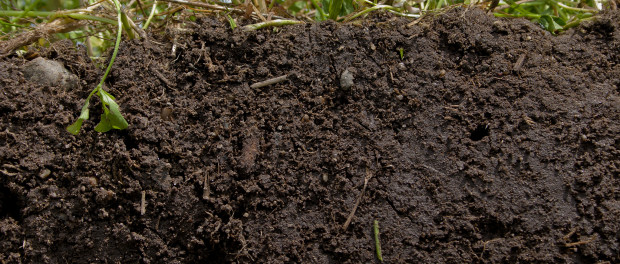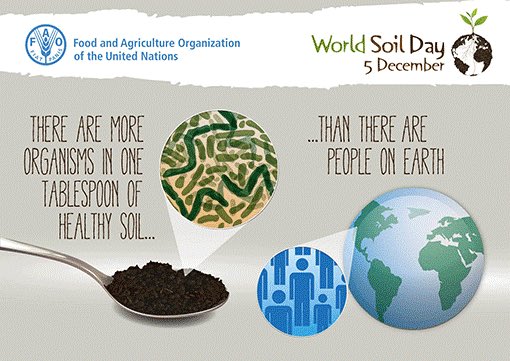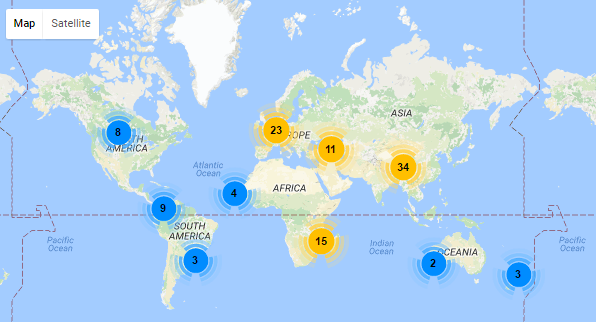A guest post by Dr. Oliver Moore

What a Healthy Soil Looks Like
“On World Soil Day, I call for greater attention to the pressing issues affecting soils, including climate change, antimicrobial resistance, soil-borne diseases, contamination, nutrition and human health.” — UN Secretary-General, Ban Ki-Moon.
Monday 5th December is the UN World Soil Day. Ban Ki-Moon’s quote above only scratches the surface of what soil is and does. Life giving, carbon sequestering, the microcosmos beneath our feet feeds us and protects us. It can however be washed away and lost through bad farming practices, from monocultural maize plantations and compaction to microbe destroying agri-industrial inputs.
Read about Soil
There are numerous sources of reading on soil and farming. Here are some:
Regeneration of soils and ecosystems
Íñigo Álvarez de Toledo’s 2015 white paper is a treasure trove of research and suggestions on soil, climate change, farming and regeneration. The paper “explains and justifies scientifically the need to give absolute priority to the regeneration of soils and ecosystems”. How carbon, soil and climate change are interconnected, the role of industrial farming in the probelm and regenerative farming in the solution are explained, while policy recommendations are also made.
The Potential of Carbon Farming
Eric Toensmeier has written extensively on agroecological methods, including and in particular agroforestry, as techniques to improve soil and fight climate change. Here he explains his ideas for permaculture magazine.
“Carbon farming is a term used to describe a suite of crops and agricultural practices that sequester carbon in the soil and in above ground perennial biomass. If widely implemented, these practices have the capacity to sequester hundreds of billions of metric tons of carbon from the atmosphere in the coming decades. If we combine carbon farming with a massive global reduction in fossil fuel emissions, it can bring us back from the brink of disaster and return our atmosphere to the “magic number” of 350 parts per million (ppm) of carbon dioxide (CO2).
Unlike high-tech geoengineering strategies, these practices can also feed people, build more fertile soils, and contribute to ecosystem health. This may seem like a bold claim – and it is – but as we scramble for solutions to our climate catastrophe, the incredible sequestration potential of the crops and practices I describe in my new book, The Carbon Farming Solution, have largely been ignored.” Happily, the article goes on to outline many of the solutions available.
What if great growing soil was under threat from development – how would you respond? Two artists took a specific path, one that helped people engage with the issue in novel ways. And in so doing, they brought different people – from across a wide spectrum – together to get to know that earth beneath their feet a little better. Find out about the Soil Sisters of the English city of Bristol. Mario Catizzone of the fantastic #People4Soil initiative tells us about it.
Sign the #People4Soil petition to encourage the EU to recognise the importance of soil
Soils Cities and Microbia – teaming with life (May 2016) This article summaries two publications on Soil and Cities and on the effect of Roundup on soil microbiota to show just how important and delicate that dirt beneath our feet is.
More on soil at arc2020.eu:
Bristol’s soil sisters bringing citizens together (May 2016)
From Mud Angels to Soil Angels (Feb 2016)
Soil in the EU – Institutional Inertia and People Progress (Feb 2016)
Drying Soils and Bad for People and Planet (Feb 2016)
Why are so few people talking about soil as a climate change solution? (Jan 2016)
4 Pour 1000 – France leads on Soil Carbon? (Dec 2015)
Slip Sliding Away – where is all the soil going? (Aug 2015)
Seven ways to save our tired soils (Feb 2013)
Soil in the news

2014 How we ended up paying farmers to flood our homes UK journalist Goerge Monbiot explains why he thinks maize plantations, and CAP contribute to flooding. UK Farmers debate Monbiot maize and soil
2015 Three part series on soil (Oliver Moore’s blog)
2016 Assessing 2015 International Year of Soil (Food First)
2016 Soil carbon storage not the climate change fix it was thought, research finds.
2016 Carbon key to building resilience on farms (Nov 2016)
2016 Soil Organic Carbon Loss (UNFAO)
2016 Soil is too small a word for it (Irish Times Nov 2016)
2016 Scientists have long feared this ‘feedback’ to the climate system. Now they say it’s happening
See also: Soil Association on Soil


